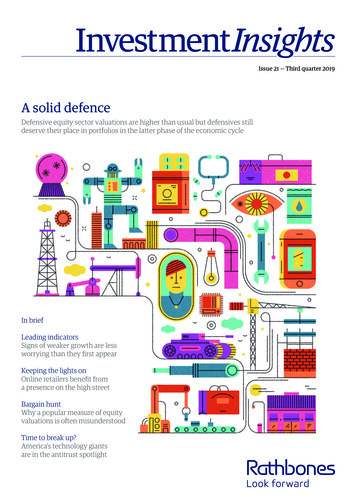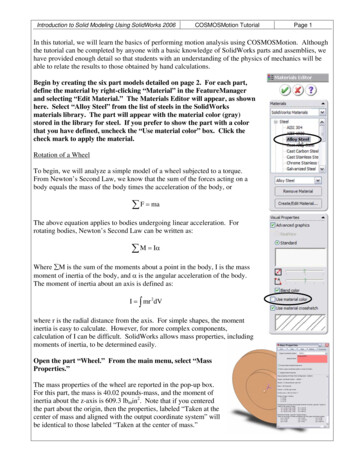
Transcription
Issue 21 — Third quarter 2019A solid defenceDefensive equity sector valuations are higher than usual but defensives stilldeserve their place in portfolios in the latter phase of the economic cycleIn briefLeading indicatorsSigns of weaker growth are lessworrying than they first appearKeeping the lights onOnline retailers benefit froma presence on the high streetBargain huntWhy a popular measure of equityvaluations is often misunderstoodTime to break up?America’s technology giantsare in the antitrust spotlight
ForewordWhile the Brexit deadline draws closer, the route to a deal between the UK and theEuropean Union (EU) shows no signs of materialising. The Conservative Party’sleadership campaign is also adding to the uncertain mood, but we believe the UK isunlikely to leave without a deal — regardless of the winner.When economic growth slows and the outlook dims, investors usually shift theirequity investments from cyclical to defensive sectors. On page 3, we explore theissues associated with this traditional approach as we enter the later stages of thecurrent business cycle.On page 5, we explain why signs of weaker economic growth may not necessarilybe cause for alarm. Although a broader range of economic indicators have fallen toindisputably weaker levels than at any time since the 2008 global financial crisis, theusual indicators of recession are yet to send a warning signal.As the rise of online shopping continues, we explore how high-street retailers areadapting to make the most of their store space on page 6. We look at the advantagesof having a physical presence, including how a shift in spending from things toexperiences has created a new trend of ‘experiential retail’.Many active investors try to identify companies or markets that look ‘cheap’ andthose that look ‘expensive’ by using the price-to-earnings (PE) ratio. On page 8, weexplore why factoring this commonly used measure into investment decisions can bemisleading and why it is unlikely to lead to outperformance.Finally, on page 9 we explore why US tech giants are facing increased regulatoryscrutiny and evaluate the risk of a breakup within the sector. We discuss the challengesof applying antitrust law to high-tech companies and how the future of the tech titansrests on political machinations and the attitudes of those in the Supreme Court.I hope you enjoy this edition of InvestmentInsights. Please visit rathbones.com toexplore our latest views on the issues shaping financial markets this year and beyond.Julian ChillingworthChief Investment Officer2rathbones.comInvestmentInsights Issue 21 Third quarter 2019
A solid defenceInvesting in defensive equitysectors as the cycle maturesWhen the pace of economic growth begins to slow and the outlook becomes moregloomy, it makes sense for investors to start shifting their equity investments awayfrom cyclical sectors and towards defensive ones, even if you don’t think a recession isnecessarily likely to ensue.We’ve identified two issues that leadus to question whether this traditionalapproach may need some adjustment aswe enter the later phases of the currentbusiness cycle.In the first instance, we’re concernedabout whether some traditionaldefensive sectors still merit their status.We explored some of the reasons in anarticle called ‘Today’s defensives maynot be fit for tomorrow’ in the January2019 edition of InvestmentInsights.For example, many companies sellingconsumer staples are under pressurefrom new-age brands that use socialmedia to target audiences cheaply andeffectively.Healthcare and pharmaceuticalcompanies usually enjoy relatively stabledemand throughout the economic cyclebut are facing increased scrutiny overdrug prices in the US, where rising costsare a hot political issue. Meanwhile, inthe UK utilities face a more punitiveregulatory outlook and possiblenationalisation if Jeremy Corbyn’sLabour Party comes to power.What’s in a name?As part of our ongoing research intowhat makes a sector or individualcompany cyclical, we’ve focused onequity sectors in the FTSE 350 Index.When economic activity is accelerating,cyclicals are supposed to outperform themarket benchmark. But we have threequestions. First, do we mean the globalor domestic economy? Second, whenwe say outperform, do we mean pricesor earnings? Third, over what periodshould we run our analysis? After all,businesses and sector compositions canchange substantially over just a couple ofdecades.In order to answer these questions,we’ve analysed share prices and theirearnings performance relative to thewider stockmarket over various periodsin response to changes in both globaland UK economic indicators. The returnsfrom different equity sectors tend to bemost dispersed during the contractionphase of the cycle. Therefore, identifyingthe right characteristics at this time couldpotentially generate the best relativereturns. The result is a list of sectorsaccording to how they tend to performthroughout the cycle. (Figure 1 showsthe sectors that are the most defensiveaccording to our calculations.)The choice between definingcyclicality in terms of economicsensitivity or market beta makes littledifference to the composition of ourlist. Similarly, whether one looks atsensitivity to a global or UK economicindicator also makes little differenceto a sector’s classification, with threeexceptions. We’ve noticed that generalretail, construction and materials,household goods and home constructionhave a strong cyclical relationship withthe UK economy, even though theyhave an insignificant or even defensiverelationship with the world economy. ItWe’ve noticed that generalretail, construction andmaterials, household goodsand home construction havea strong cyclical relationshipwith the UK economy.Figure 1: Most defensive sectors (least cyclical)Difference in 12-month forward PE ratios between individual sectors and the stock market.Rathbonesdefensivenessscore25 yearsPE relative to marketLast threeLatestslowdownsPharmaceuticals0.85 2.9x 4.1x 4.5xBeverages0.85 1.8x 0.5x 9.5xUtilities0.75-1.5x-1.5x 2.1xFood and drugretailers0.75 1.3x 2.3x 4.1x 2.1xFood producers0.70-0.1x-2.6xHealthcare0.65 3.3x 3.2x 4.1xNonlife insurance0.60 0.4x 3.4x 0.9xMobile telecoms0.55 8.6x 11.8x 2.7xElectricity0.50-1.8x-1.1x-0.3xSource: Datastream and Rathbones.InvestmentInsights Issue 21 Third quarter 2019rathbones.com3
A solid defenceMeasuring valueThe second reason to be cautious aboutdefensive sectors is that they look a bitexpensive at the moment across variousmeasures of value. One explanationis that equity investors have beenunusually cautious over the past decade.Even though the global economy hasbeen growing, the slow pace of therecovery since the financial crisis hasdampened confidence.But when defensive sectors are alsoexpensive, this creates something of adilemma. We believe it makes sense to bedefensively positioned within equities,but are we really going to be better off ifwe’re buying expensive defensives?In order to answer this question,we’ve explored whether today’sdefensive sectors really are expensive.In deciding where to put money withinUK equities, the relative valuation isimportant. Therefore, we’ve looked at thedifference between the price—earnings(PE) ratio of each sector and the overallstock market. We’ve added the results toour defensiveness ranking (figure 1).The third column of figure 1 showsthe 25-year average of each sector’srelative PE. The fourth shows the averagerelative PE for the last three slowdowns(the early 1990s, early 2000s and theperiod leading up to the 2008 financialcrisis). The fifth column provides ameasure of today’s valuations comparedwith the past. It confirms that manydefensive sectors are expensive, evencompared with where they usually tradeduring a slowdown (which is when theyare most appealing).Are they worth it?Are these defensive sectors tooexpensive to include in portfolios?To help answer this question, we’vecompared the initial (absolute) PE ofthe sectors just before the past threeslowdowns with their subsequentreturns relative to the market. We see noevidence to suggest higher valuationsinhibit the performance of defensivesectors during a downturn.In addition, when we differentiate4rathbones.comcyclicals from defensives, we can seethat cyclicals underperformed themarket by around 11% on averageeven though they started with lowervaluations. Meanwhile, defensive sectorsoutperformed by 11% despite moreexpensive starting valuations.In the next stage of our analysis weput the initial valuations into a relativeperspective by using valuation spreads— the amounts that sectors’ valuesdiffer from that of the total market. Thisdoes reveal a statistically significantrelationship between a sector’s initialvaluation and subsequent performanceduring a slowdown, especially when weisolate cyclical and defensive sectors.Notably, the performance of cyclicalsectors during periods when theeconomy is slowing are more susceptibleto their initial valuation relative to that ofthe wider market. The higher a sector’sinitial relative PE, the worse its relativeperformance during the followingdownturn.Yet this relationship is weak amongdefensive sectors (particularly if weexclude mobile telecoms stocks duringthe dotcom bust). In most cases,regardless of the initial relative valuation,defensive sectors tend to outperformduring a slowdown (figure 2).There is a weak statistical relationshipbetween the initial relative PE andsubsequent performance, suggestingthat defensive outperformance iseven better when starting positionsare cheaper. But this implies thatvaluations would have to be a whopping15 times more expensive than themarket before defensives would fail tooutperform. None of our highlighteddefensive sectors are anywhere near thatexpensive, suggesting they continue toearn their place in portfolios as the paceof economic growth begins to slow.In most cases, regardless of the initialrelative valuation, defensive sectors tendto outperform during a slowdown.Figure 2: Measuring valueEach dot in this chart shows the return of UK defensive sectors during each of the past threeeconomic recessions. Most times defensive sectors have beaten the market (above zero onthe y axis) and it made little difference how much you paid for them (more expensive is to theright on the x axis, cheaper is to the left).Defensive sectors invariably outperform, regardlessof how expensive they are when you buy them50Relative return over total marketduring slowdowns (%)may be worth bearing this in mind if theUK economy diverges from the globalbusiness cycle as a result of Brexit.403020100-10-20-10-8-6-4-2024Starting relative forward 12-month PE ratio to benchmarkSource: Datastream and Rathbones.InvestmentInsights Issue 21 Third quarter 20196810
Leading indicatorsSigns of weaker growth are lessworrying than they first appearA broader swathe of economic indicators— of the recent past, present and future— have fallen to indisputably weakerlevels than at any time since the 2008global financial crisis. That means wehave more reasons than at any time overthe past decade to be worried about theoutlook for the US and global economiesover the next 12 months.For example, US industrialproduction is contracting quarteron-quarter (figure 3). The volume ofKorean exports is also contracting, as areorders of Japanese machine tools andglobal sales of microchips. The Germanmanufacturing Purchasing Managers’Index (PMI) — a much-watched measureof business confidence — is below50 (commonly seen as the thresholdbetween ‘boom’ and ‘bust’), as are anumber of other manufacturing PMIsaround the world.Don’t cash in your chipsHowever, we shouldn’t infer from thesesignals that it’s time to cash in thechips. A mild contraction in many ofthese indicators is not actually unusual.Quarterly US industrial productiongrowth has been negative five timesnow since the recovery began in 2009,sometimes for prolonged periods.This is the third time Korean exportorders have shrunk; the same goes forJapanese machine tools orders and globalmicrochip sales. It’s the fourth occasionthat the German manufacturing PMI hascrossed below that boom/bust threshold.The fact is, just below 50 isn’t actuallyconsistent with bust.Since September 2018, we’vebeen noting that slowing economicmomentum meant that it made sense tobe positioned defensively within equitymarkets, while still preferring them overbonds. The bottom line is that we believethese weak indicators and the poormacroeconomic momentum they pointto are reason to maintain this bias. Theyare not yet indicating that this is likelyto be more than a mid-cycle slowdownand that a recession within the next 12months is more likely than not. And soit’s not yet time to get out of equities andhoard cash and cash-like bonds. For sure,a recession may turn out to be the waywe’re heading, but such a conclusion — atleast from the business cycle indicatorsper se — is not currently supported bydue analysis and hypothesis testing.Moreover, in combination, the mostanticipatory economic indicators ofrecession — those that help us assessthe risks to growth over the next 12months — are yet to send a recessionarysignal. These indicators include the yieldcurve, the inflation-adjusted growth rateof money supply (the stock of moneyreadily available to spend), and thedifference between real interest ratesand the ‘neutral’ rate of interest (all forthe US). They regularly signal a recessionwell in advance of the peak in equitymarkets — five months on average sincethe 1960s — giving investors ampletime to reposition. In other words, thereis rarely any need to jump the gun bytrying to anticipate the already highlyanticipatory indicators.Of course, we are vigilant of therisks and remain cautious. Businesscycle indicators only take us so farand we need to ask what they are nottelling us as much as what they are. Theintensifying trade war makes many of usespecially nervous, as we have writtenabout many times since before Do
Bargain hunt Why a popular measure of equity valuations is often misunderstood Time to break up? America’s technology giants are in the antitrust spotlight Defensive equity sector valuations are higher than usual but defensives still deserve their place in portfolios in the latter phase of the economic cycle A solid defence Issue 21 — Third quarter 2019. 2 rathbones.com InvestmentInsights .











